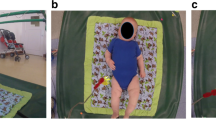Abstract
Objective
The objective of this study is to evaluate the use of nests on general movements (GM) and posture in very preterm infants at term age.
Method
Seventeen high-risk preterm infants—less than 30 weeks of gestation (GA)—underwent a video recording, lying in supine position, with or without nest. Posture, GM quality, and movements made around the child’s midline, as well as abrupt movements and frozen postures—in extension or flexion of the four limbs—were analyzed.
Results
Nest did not modify quality of GM. Children significantly adopted a curled-up position. The nest system was associated with an increase in movements toward or across the midline, as well as reduction of the hyperextension posture and head rotation movements. Frozen postures in flexion or extension, as well as abrupt movements of the four limbs, were reduced but not significantly.
Conclusions
Nest helps very preterm infants to adopt semi-flexed posture and facilitates movements across the midline and reduces movements of spine hyperextension, without GM global quality modifications.

Similar content being viewed by others
References
Larroque B, Breart G, Kaminski M, Dehan M et al (2004) Survival of very preterm infants: Epipage, a population based cohort study. Arch Dis Child Fetal Neonatal Ed 89:F139–F144
Spittle A, Orton J, Anderson P, Boyd R, Doyle LW (2012) Early developmental intervention programmes; The Cochrane Library Issue 12
Westrup B, Von Kleberg A, Eichwald K et al (2000) A randomized controlled trial to evaluate the effects of the newborn individualized developmental care and assessment program in a Swedish setting. Pediatrics 105:66–72
Monterosso L, Kritjanson LJ, Cole J et al (2003) Effect of postural supports on neuromotor function in very preterm infants to term equivalent age. J Pediatr Child Health 39:197–205
Provasi J, Lequien P (1993) Effect of non-rigid reclining infant seat on preterm behavioral states and motor activity. Early Hum Dev 35:129–140
Ferrari F, Bertoncelli N, Gallo C et al (2007) Posture and movement in healthy preterm infants in supine position in and outside the nest. Arch Dis Child Fetal Neonatal Ed 92:386–390
De Graaf-Peters VB, de Groot–Hornstra AH, Dirks T (2006) Specific postural support promotes variation in motor behaviour of infants with minor neurological dysfunction. Dev Med Child Neurol 48:966–972
Vaivre-douret L, Golse B, Thomas N, Janaud J-C (2009) Favoriser la prévention posturale du nouveau-né prématuré. Soins Pédiatr Puéric 250:35–39
Paneth N, Chair MPH (1999) Classifying brain damage in preterm infants. J Pediatr 134:527–529
Prechtl HFR (1990) Qualitative change of spontaneous movements in fetus and preterm infants are a marker of neurological dysfunction. Early Hum Dev 23:151–158
Ferrari F, Cioni G, Prechtl HFR (1990) Qualitative changes of general movement in preterm infants with brain lesions. Early Hum Dev 23:193–231
Einspieler C, Prechtl HFR, Ferrari F, Cioni G, Arend FBOS (1997) The qualitative assessment of general movements in preterm, term and young infants – review of the methodology. Early Hum Dev 50:47–60
Kouwaki M, Yokochi M, Togawa Y et al (2014) Spontaneous movements in the supine position of preterm infants with intellectual disability. Brain Dev 36:572–577
Slevin M, Murphy JFA, Daly et al (1997) Retinopathy of prematurity screening, stress related responses, the role of nesting. Br J Ophtalmol 81:762–764
Butcher PR, van Braeckel K, Bouma A et al (2009) The quality of preterm infant’s spontaneous movements: an early indicator of intelligence and behaviour at school age. J Child Psychol Psychiatry 50:920–930
Kodric J, Susteric B, Paro-panjan D (2010) Assessment of general movements and 2,5 year developmental outcomes: pilot results in a diverse preterm group. Eur J Pediatr Neurol
Philippi H, Karch D, Kang KS, et al (2014) Computer –based analysis of general movements reveals strereotypies predict cerebral palsy. Dev Med Child Neurol 1–7
Kanemaru N, Watanabe H, Kihara H et al (2014) Jerky spontaneous movements at term age in preterm infants who later developed cerebral palsy. Early Hum Dev 90:387–392
Kanemaru N, Watanabe H, Kihara H, et al (2013) Specific characteristics of spontaneous movements in preterm infants at term age are associated with developmental delay at age 3 years. Dev Med Child Neurol 713–721
Woollacott M, Sveistrup H, Swinne SP, Massion J, Heur H et al (1994) The development of sensorimotor integration underlying posture control in infants during the transition to independence stance. Interlimb coordination neural dynamical and cognitive constraints. Academic, San Diego, pp 371–389
Inguaggiato E, Sgandurra G, Perazza S, Guzzetta A, Cioni G (2013) Brain reorganization following intervention in children with congenital hemiplegia: a systematic review. Neural Plast 1–8
Conflict of interest
The authors declare no conflict of interest.
Author information
Authors and Affiliations
Corresponding author
Appendices
Appendix 1
Appendix 2
Rights and permissions
About this article
Cite this article
Zahed, M., Berbis, J., Brevaut-Malaty, V. et al. Posture and movement in very preterm infants at term age in and outside the nest. Childs Nerv Syst 31, 2333–2340 (2015). https://doi.org/10.1007/s00381-015-2905-1
Received:
Accepted:
Published:
Issue Date:
DOI: https://doi.org/10.1007/s00381-015-2905-1




